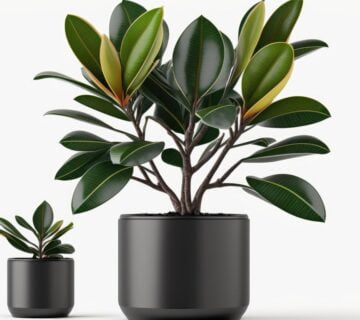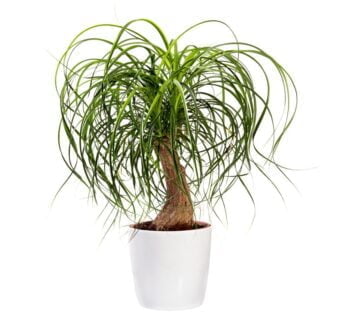Zebra plant – Calathea Zebrina
Zebra Plant, scientifically known as Calathea zebrina, is a unique and striking houseplant appreciated for its distinctive zebra-like patterns on the leaves.
Leaf Appearance:
The Zebra Plant features elongated leaves with bold, dark green stripes resembling zebra stripes on a light green background. The contrasting patterns make it an eye-catching addition to any indoor space.
Native Habitat:
Calathea zebrina is native to the tropical rainforests of Brazil. It thrives in humid and shaded environments, which makes it well-suited for indoor cultivation.
Light Requirements:
Zebra Plants prefer bright, indirect light. Avoiding direct sunlight is essential as it can scorch the delicate leaves. Placing the plant near a north or east-facing window is ideal.
Watering Needs:
Maintaining adequate moisture levels is crucial for the Zebra Plant. It prefers consistently moist soil but not waterlogged conditions. Watering when the top inch of soil feels slightly dry is a good guideline.
Humidity Preference:
Being native to rainforest environments, the Zebra Plant enjoys high humidity. Consider misting the leaves or placing a humidifier nearby to create a humid atmosphere.
Temperature Tolerance:
Zebra Plants thrive in temperatures between 60-75°F (15-24°C). They are sensitive to cold drafts, so protecting them from sudden temperature drops is essential.
Soil Requirements:
Well-draining and fertile soil are essential for the Zebra Plant. A good drainage mix of peat moss, perlite, and potting soil is recommended.
Pruning and Maintenance:
Regularly removing yellowed or damaged leaves helps maintain the plant’s overall health and appearance. Gently wiping the leaves with a damp cloth helps keep them clean and free from dust.
Propagation Methods:
Zebra Plants can be propagated through division or stem cuttings. Dividing the plant during repotting or taking stem cuttings in spring or early summer are effective propagation techniques.
Toxicity:
It’s important to note that the Zebra Plant is considered mildly toxic to pets. Keep it out of reach of curious cats and dogs to avoid potential ingestion.
Air Purifying Qualities:
It is one of the best houseplants in your home because it tops NASA’s air-purifying plant list. It effectively removes harmful chemicals like ammonia, toluene, xylene and formaldehyde.
By providing the right conditions of light, water, humidity, and temperature, you can enjoy the beauty of the Zebra Plant and create a vibrant and tropical atmosphere in your indoor spaces.
Things to know about CALATHEA
Common (vernacular) Name
कैलेथिया (Hindi), Calathea, Zebra Plant, Striped-leaved Maranta, Prayer Plant, Cathedral Plants, Peacock Plants, Rattlesnake Plants and many more.
Botanical Name
Calathea
Origin
Southeastern Brazil
Family
Marantaceae – arrowroot
Plant Type
Tropical plant
Plant Features
Ornamental / Evergreen / Exotic
Life Cycle
Perennial
Landscape Uses
General, Interiorscape and Container Planting
Species
Calathea crocata, Calathea lancifolia, Calathea makoyana, Calathea ornata, Calathea roseopicta, Calathea rufibarba, Calathea makoyana, Calathea orbifolia, Calathea zebrina etc.
Varieties
It comes with over 300 of different varieties in a diversity of leaf. Some famous verities are available in a myriad of colors and exotic variegation, such as Calathea crocata, Calathea makoyana, Calathea ornata, Calathea zebrina, Calathea anderssonii, Calathea anulque, Calathea asplundii, Calathea barryi, Calathea brenesii, Calathea caesariata, Calathea calderon-saenzii, Calathea carlae, Calathea casupito, Calathea chiriquensis, Calathea cofaniorum, Calathea confusa, Calathea congesta, Calathea croatii, Calathea crotalifera, Calathea erythrolepis, Calathea fredgandersii, Calathea fredii, Calathea galdamesiana, Calathea gentryi, Calathea grandifolia, Calathea guzmanioides, Calathea hagbergii, Calathea harlingii, Calathea inscripta, Calathea ischnosiphonoides, Calathea jondule, Calathea lanibracteata, Calathea lanicaulis, Calathea louisae, Calathea lasiostachya, Calathea lateralis, Calathea latrinotecta, Calathea lutea, Calathea marantina, Calathea monstera, Calathea multispicata, Calathea neillii, Calathea neurophylla, Calathea nitens, Calathea oscariana, Calathea platystachya, Calathea pluriplicata, Calathea plurispicata, Calathea ravenii, Calathea recurvata, Calathea retroflexa, Calathea rubribracteata, Calathea shishicoensis, Calathea similis, Calathea spiralis, Calathea striata, Calathea tarrazuensis, Calathea timothei, Calathea toroi, Calathea trianae, Calathea utilis, Calathea velutinifolia, Calathea verruculosa and Calathea yawankama.
Size
Height : 1 to 3 feet tall and Width : 1 to 2 feet wide when mature.
Indoors or Outdoors
Outdoors : Anthurium can be used outdoors in shady plantings, avoid direct sun light.
Indoors : Excellent plant grow in bright light or indirect light. Best indoor plants for beginners.
Blooming / Flowering
Blooming period is throughout the year.
Flower Colour
It’s come with a contrasting spadix Gold, Yellow, Orange, Pink, White, Green, Purple, Red, Burgundy, Multicolored and Variegated colours.
Lucky Plant
According to Feng Shui, It bring Good Luck in your relationships.
Lighting / Sun Exposure
Bright Indirect Sunlight.
Temperature
Grow best preferably warm temperature above 21°C and can be tolerate max temp. as high as 32°C.
Growth Rate
Anthurium is a slow to moderate growers plant.
Watering
Moderate watering, Mist or over head sprinkler to provide water and to improve relative humidity. Not tolerate overwatering it may cause root damage and yellowing of the leaves.
Fertilizer
Slow-release fertilizer, or a water-soluble liquid fertilizer once or twice in the growing season (Spring through Summer).
i.e. - Cow dung, DAP, Compost, NPK 30-10-10 fertilizer, liquid organic fertilizer etc.
Pruning
Pruning of Anthurium not much is needed. However, trimming away only discolored or dead leaves.
Propagation
Seeds : The best time to sow your Anthurium seeds is in the end of Winter / early Spring but it can't can give good result.
Stem Cuttings : The easier methods of propagation of Anthurium in water or in soil via stem cuttings, and can be done during the warm growing season.
Division : Division of Anthurium can be done in Rainy season, or better in February to March.
Dormancy Period
Month : November to February (winter season)
Shed their leaves and show poor growth, Watering minimally.
Avoid : Propagate, Fertilize and Repotting.
Container
Ceramic Pot, Plastic Pot, Terracotta or Clay Pot is preferred, which ensures good drainage as well as water holding capacity.
Soil Type
A well-drained Loam / Coarse potting soil is recommended as well as water holding capacity. Prevent soggy potting medium.
Our recommendation for potting mix : Equal part mixture of Garden Soil (25%) + Compost (25%) + River Sand (25%) + Cocopeat (25%). You can substitute pieces of Charcoal, Vermicompost, Perlite etc.
Soil pH
Lightly Acidic soil - Ideally 5.5 to 6.5 pH (potential of hydrogen) is recommended for Anthurium.
Repotting
It is advisable to repot the Anthurium every year or two preferably spring to midsummer season.
Maintenance
Low maintenance and easy to grow.
Properties
Toxic or Poisonous to both humans and pets upon ingestion.
Benefits
Excellent indoor air purifier, Anthurium plants turns CO2 into oxygen. It purifies indoor air by removing harmful chemicals like ammonia, toluene, xylene and formaldehyde.
Special Features
Doesn't attract hummingbirds and pollinators like butterflies and bees or wasps.
Infestation / Pests
Aphids, Scale insects, Thrips, Mealy bugs, Spider mites and caterpillars etc.
Diseases / Problem
Physiological Problem : Anthracnose, Leaf Spot and Powdery Mildew.
Bacterial Problem : Bacterial Blight, Bacterial Wilt and Black Nose Disease.
Fungal Problems : Root Rot and Water Mold.
Some Glimpse of CALATHEA











No comment